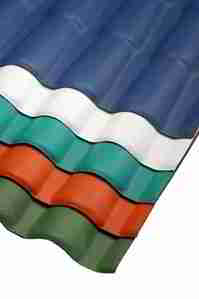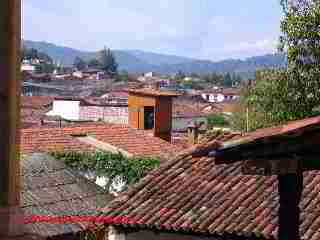 Clay Tile, Concrete Tile, & Fiber-Cement Product Choices
Clay Tile, Concrete Tile, & Fiber-Cement Product Choices
- POST a QUESTION or COMMENT about choices of types of roofing tiles & tile materials
Clay tile roofing tile colors, materials, choices guide:
This article compares the features, colors, shapes, and product choices among clay roof tiles, concrete roof tiles, and composite or fiber cement roofing products.
This article series explains clay tile roofing types, clay roofing tile inspection, tile roofing diagnosis, & tile roof repair.
InspectAPedia tolerates no conflicts of interest. We have no relationship with advertisers, products, or services discussed at this website.
Clay, Concrete, & Composite / Fiber-Cement Tile Roof Product Choices
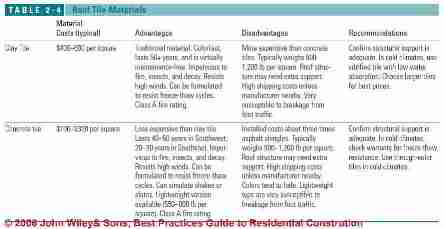 This article series discusses best practices in the selection and installation of residential roofing.
This article series discusses best practices in the selection and installation of residential roofing.
This article includes excerpts or adaptations from Best Practices Guide to Residential Construction (Steve Bliss, J Wiley & Sons) , by Steven Bliss, courtesy of Wiley & Sons. Our page top photograph shows some old clay tile roofs located in Patczuaro, Mexico.
[Click to enlarge any image or table]
Tile roofing accounts for about 8% of new residential roofs in the United States, primarily in the Southeast, Southwest, and on the West Coast. In addition to its durability and natural beauty, tile is impervious to fire, insects, and rot, and it can be formulated to withstand freeze-thaw cycles.
When colored white, tile roofing has been shown to reduce cooling costs by up to 22% for barrel or flat tile (compared to black asphalt shingles in tests conducted by the Florida Solar Energy Center).
Since most tile roofs carry a 50-year warranty and a Class A fire rating, they are a popular choice for high-end projects, particularly in warm climates.
[Click to enlarge any image or table]
Nearly all roofing tiles in the United States were traditional clay until the 1960s when concrete tile first gained acceptance. Concrete tile now dominates most tile roofing markets, primarily due to its lower cost (see Table 2-4 above).
Where weight is a concern, options include lightweight concrete tiles or fiber-cement shingles, which typically weigh even less. Fiber-cement roofing typically simulates slate or wood shakes and provides a Class A fire rating at a cost comparable to wood shakes.
Tile Shape Choices for Clay, Concrete, & Composite Tile Roofs
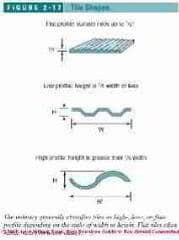
All roofing tiles can be classified as high-profile, low-profile, or flat (see Figure 2-17).
Common high-profile roofing tiles include two-piece pan-and-cover Mission tile and one-piece Spanish S-tiles.
Low profile roof tile styles include a wide variety, many with a double-S shape that creates multiple water courses.
Many flat roof tiles are shaped and colored to simulate slate or wood shakes.
In general, patterns using smaller tiles cost more per square for both materials and labor than patterns using larger tiles.
Concrete roofing and concrete roof tiles are discussed separately at CONCRETE ROOFING.
Other composite roofing materials that are cemetious include ASBESTOS & FIBER CEMENT ROOFING
Clay Roofing Tile Properties & Features
To make clay roofing ttiles, moist clay is extruded through a die or cast in a mold and then fired in a kiln until the clay “vitrifies,” fusing the particles together. Complete vitrification will create a strong tile with very low water absorption, which protects tile from freeze-thaw damage in cold climates or damage from salt air in coastal areas.
Where regular freeze-thaw cycling is expected, roof tiles in the U.S. should comply with ASTM C1167 Grade 1, which allows minimal water absorption. Grade II tile provides moderate resistance to frost action, and Grade III tile is porous and should not be used in freeze-thaw areas.
When buying clay tile, look for at least a 50-year warranty on both durability and fading. Costs vary widely, depending on quality, style, and the shipping distance required. In general, patterns using smaller tiles will cost more for both materials and labor.
Color Choices for Clay Roof Tiles
Clay tiles come in a wide range of colors. Colorthrough tile takes the natural color of the clay, ranging from light tan to pink and red. Other colors can be added to the tile surface as a clay slurry before firing, but slurry coatings are only suitable for warm climates, as they cannot withstand freeze-thaw cycles. Clay tile can also be colored with ceramic glazes to create a durable, glass-like surface in just about any color. In general, clay tiles do not fade in the sun.
Blended Pattern Choices for Clay Roof Tiles
Some jobs require the installer to mix two or three different colors in a random pattern. The best way to achieve this is to premix bundles on the ground with the correct proportion of each color, then send them up to the roof for installation. Periodically inspect the roof from the ground for hot spots or streaking.
Clay Roof Tile Styles
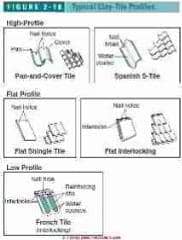 Clay roof tiles are available in traditional
two-piece styles, one-piece profiles, and flat profiles
(Figure 2-18).
Clay roof tiles are available in traditional
two-piece styles, one-piece profiles, and flat profiles
(Figure 2-18).
Designs are either overlapping or interlocking, with protruding lips that lock the tiles together and form a weather seal. Many flat clay tiles interlock. Interlocking designs are recommended for regions with heavy rain or snow. Manufacturers provide special trim tiles to seal the voids formed at ridges, rakes, and hips.
- Pan and cover clay roof tiles. This traditional two-piece style, also
called barrel- or Mission-style, is installed in pairs
with the cover tile overlapping the pan tile. It provides
an attractive high-profile look but is labor-intensive
and expensive to install.
Variations include Roman and Greek profiles, which have flat, rather than curved, pan tiles. Tiles typically range from 8 to 12 inches in width and from 16 to 19 inches long. - Spanish Clay S-tile roofing tiles. These one-piece tiles provide the high-profile look of traditional pan-and-cover tile but with simpler installation. The most popular S-tiles measure about 13 inches wide by 16 1/2 inches long. Other common sizes are 8 3/4 x11 and 9x14 inches.
- Flat shingle clay roof tile. These are laid in a double thickness, like slate. Widths range from 6 to 8 inches, lengths from 12 to 18 inches.
- Interlocking clay roof tile. These are either flat or low profile and are laid in a single thickness with a 3-inch overlap. They have interlocks on the sides with channels or ribs, and butts may also lock into the tops of the underlying shingles. Contours and ribs add strength to the tiles. Widths typically range from 9 to 13 inches and lengths from 11 to 16 inches.
Details about clay tile roofing installation, inspection, maintenance, and repair are at
Concrete Roofing Tile Properties & Features
Also see our home page for concrete roofing
at CONCRETE ROOFING.
Concrete tiles were introduced to the United States in the early 1900s, but they did not catch on until the 1960s. They now account for more than half the tiles sold in the United States.
In Europe, over 90% of new houses have concrete tile roofs. Concrete tiles cost as little as half as much as clay and offer both traditional and flat styles that simulate slate roofing and wood shakes.
High-quality concrete tiles should last up to 50 years in arid climates and up to 30 years in hot, humid climates.
While some early products faced problems with freeze-thaw cycling, most newer formulations are made to withstand winter weather. In cold climates, make sure the product is warranted for freeze-thaw durability.
Special lightweight concrete tiles weighing under 600 lb per square are gaining in popularity. Although they cost more than standard concrete tiles and are more prone to breakage, they are easier to handle and suitable for applications where the roof structure cannot support the weight of standard tiles.
Lightweight roof tiles cannot support foot traffic without adding walking pads to distribute weight or filling the space under the tiles with polyurethane foam. They are also not recommended for high-snow regions.
Color Choices in Concrete Roofing Tiles
Concrete tiles can be surface colored with a slurry of iron-oxide pigments applied to the surface or have the color added to the concrete mix for a more durable, and expensive, through-color. Through-color choices are more limited, and the colors are more subdued. Either type of tile is also sealed with a clear acrylic spray to help with curing and efflorescence.
While the color-through tile will hold its color better than the slurry type, particularly under freeze-thaw cycling, all concrete tile coloring can be expected to fade and soften over time. Surface textures can also be added to flat concrete tiles to simulate wood shakes or shingles.
Concrete Roof Tile Styles: Spanish S Tiles, Low Profile Double Roman Tiles, Flat Shake Tiles
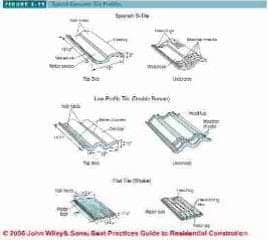 Concrete tiles are available in
shapes that simulate traditional clay styles as well as flat
profiles that simulate wood or slate (Figure 2-19 at left).
Concrete tiles are available in
shapes that simulate traditional clay styles as well as flat
profiles that simulate wood or slate (Figure 2-19 at left).
Most concrete roofing tiles are designed with an interlocking channel on the left edge that is lapped by the next tile.
Underneath each tile is a head lug at the top and series of ridges at the bottom. The head lug fits over the top of a horizontal 1x batten, if these are used.
Otherwise the concrete roof tile sits directly on the roof deck. The ridges at the bottom (called nose lugs or weather checks) match the profile of the tile below, creating a barrier against windblown rain and snow.
Concrete roofint tile Manufacturers provide special trim tiles to fill in the large voids that profile tiles leave at ridges, rakes, and hips.
While many sizes are available, the most common concrete tiles measure 12 to 13 inches wide by 16 1/2 or 17 inches long.
Concrete Spanish S-tile. These provide the look of traditional two-piece Mission tiles but with simpler installation. Nearly all have interlocking side channels.
Interlocking low-profile concrete roof tile. These have a less pronounced double-S shape and interlocking joints and side channels. Heads and butts may also interlock or simply overlap.
Interlocking flat concrete roof tile. These simulate clay roof tiles, wood shakes, and slate. Ridges, hips, and rakes are easier to seal than with curved tiles.
Concrete roofing alternative designs, products, details, drawings, and photographs of concrete roofing tiles and construction are at CONCRETE ROOFING
Fiber-Cement Roofing Tile Properties
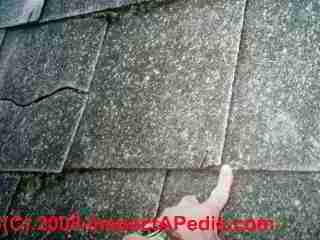 Early generations of fiber-cement roofing products using
asbestos fibers were used successfully in the United States
for over 50 years. Articles discussing these products, including cement-asbestos roofing shingles, corrugated roofing, and related products are found at:
Early generations of fiber-cement roofing products using
asbestos fibers were used successfully in the United States
for over 50 years. Articles discussing these products, including cement-asbestos roofing shingles, corrugated roofing, and related products are found at:
- ASBESTOS & FIBER CEMENT ROOFING
- Asphalt-asbestos Roofing Materials
- Cement-asbestos roof shingles
- Environmental Issues - Asbestos Roofing/Siding
- ASBESTOS CEMENT SHINGLE WEAR SIGNS
- MAINTENANCE TIPS FOR ASBESTOS CEMENT SHINGLES
- PERMATEK SHAKE ROOF REPAIR METHODS
- REPLACEMENTS FOR ASBESTOS CEMENT SHINGLES
- Corrugated Cement-Asbestos Roofing
- Asbestos Roof Power Washing
- Asphalt-asbestos Paints & sealants
- Warranty & Class Actions, Fiber Cement Shingles
Newer formulations introduced in the 1980s and 1990s used wood fibers instead of asbestos and were marketed widely in the western United States as a fire-resistant alternative to wood shakes. Made from a mixture of Portland cement and wood fibers, they weighed 400 to 600 pounds per square and were designed to imitate slates or wood shakes. They promised excellent resistance to insects, fungus, fire, and weathering and carried warranties ranging from 25 to 50 years.
Performance Problems of Fiber Cement Roofing Tiles: Cement + Wood
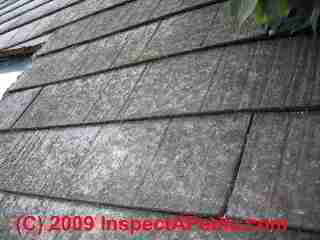
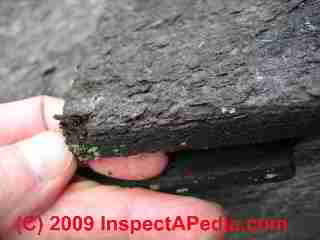
Within five years of installation, however, many of the fiber-cement shakes began to deteriorate. Problems included surface crazing, cracking, delamination, and softening and resulted in a number of lawsuits against key manufacturers and several companies abandoning the product. The problems were generally linked to high water absorption, which created an alkaline solution that was corrosive to the wood fibers.
See our complete "List of Fiberboard & Fiber Cement Roof Shingle Warranty Claims Companies & Website" found
at CEMWOOD ROOFING (American Cemwood fiber cement roofing shingles,shakes, and roof failures) for details about fiber cement roofing failures, product identification, warranties, and warranty claims information.
Also see FIBERBOARD ROOFING & FIBER-WOOD ROOFING where we describe similar products including Masonite™ Woodruf™ fiberboard roof shingles,™and similar products shown here.
Some products have fared better than others. In general, products that are steam-cured in an autoclave will have lower water absorption, but they tend to be more brittle.
Duralita™, an alternative to both clay roofing tiles as well as other fiber reinforced cement roofing products.
Details about Duralita are at DURALITA & METAL TILE ROOFS
Other examples of corrugated roofing products (that do not look like clay roof tiles) can be seen at Corrugated Cement-Asbestos Roofing.
Many fiber cement roofing products sold in the U.S. are represented as complying with ASTM C1225, a standard for nonasbestos fiber-cement roofing shingles; but in its current form, this standard does not guarantee long-term durability.
Watch out: Only a product with a proven long-term track record in a specific climate zone should be considered.
-- Adapted with permission from Best Practices Guide to Residential Construction (Steve Bliss, J Wiley & Sons) .
Clay & Concrete Roof Tile Product Manufacturers
Concrete Roof Tiles
- Bartile Roofs www.bartile.com
- Eagle Roofing Products www.eagleroofing.com
- Entegra Roof Tile www.entegra.com MonierLifetile www.monierlifetile.com
- Vande Hey-Raleigh www.vhr-roof-tile.com
- Westile www.westile.com
Clay Roof Tiles
- Altusa, Clay Forever LLC www.altusa.com
- Ludowici Roof Tile www.ludowici.com
- MCA Clay Tile www.mca-tile.com
- U.S. Tile Co. www.ustile.com
Tile Fasteners and Adhesives
- Dow Building Products www.dow.com/buildingproducts Tile Bond polyurethane foam tile adhesive
- Fomo Products www.fomo.com Handi-Stick polyurethane foam tile adhesive
- Newport Fastener www.newportfastener.com Twisted wire systems, hurricane clips, nose clips, and the Tyle-Tye TileNail
- OSI Sealants www.osisealants.com RT 600 synthetic rubber tile adhesive
- Polyfoam Products www.polyfoam.cc Polyset and Polyset One polyurethane foam tile adhesives
- Wire works, Inc. www.wireworks-inc.com Tile hooks, hook nails, copper and stainless-steel nails
- - Adapted with permission from Best Practices Guide to Residential Construction (Steve Bliss, J Wiley & Sons) .
Reader Comments, Questions & Answers About The Article Above
Below you will find questions and answers previously posted on this page at its page bottom reader comment box.
Reader Q&A - also see RECOMMENDED ARTICLES & FAQs
Question: why the flat concrete tile roof installation appears wavy or rolling
(Aug 6, 2011) W.K. said:
Need to know why the flat concrete tile roof installation appears wavy or rolling - is it because the framing is off or roof stack of tiles before installation
Reply:
WK a common source of apparent wavy concrete roof tiles (or slates or clay tiles) is loosening fastenings; if nails pop up from the roof deck to which they were nailed they can push up the concrete roof tiles.
A second, but not common, problem that could give uneven roof surfaces would be poorly-nailed plywood roof decking that is buckling due to heat or moisture changes.
A third, more serious problem would be movement or damage to the supporting roof structure itself. I'd think you could see that problem from inside the building or its attic.
Question: problems with fiber cement tiles with non alkaline glass fibers
(Nov 21, 2012) Richard J B said:
Do you know of any problems with fiber cement tiles with non alkaline glass fibers having erosion problems in the Northeast U.S.?
Hoping to hear from you
Have a happy Thanksgiving
Richard
Reply:
Richard,
Not on the products I've inspected. But I could imagine some environments (downstream from a sulfuric acid factory) that might be a factor. If you have seen a particular problem on your roof, send me some sharp photos and we can pose some followup questions that might help.
...
Continue reading at CLAY TILE ROOF STYLES, DESIGNS or select a topic from the closely-related articles below, or see the complete ARTICLE INDEX.
Or see these
Recommended Articles
- ASBESTOS & FIBER CEMENT ROOFING
- CLAY TILE ROOFING - home
- CLAY TILE ROOF BATTENS & STACKING
- CLAY TILE ROOF CONNECTIONS
- CLAY TILE ROOF DAMAGE & WEAR
- CLAY TILE EAVES, HIP & RAKE DETAILS
- CLAY TILE ROOF FLASHING
- CLAY TILE ROOF FLASHING LEAKS
- CLAY TILE ROOF SLOPE, DECK & UNDERLAY
- CLAY TILE ROOF SPECIFICATIONS
- CLAY TILE ROOF SUPPLIERS
- CLAY TILE ROOF STYLES, DESIGNS
- CLAY TILE WIND & SEISMIC CONNECTORS
- CLAY, CONCRETE, FIBER CEMENT ROOF TILE CHOICES
- CONCRETE ROOFING
- DURALITA & METAL TILE ROOFS
Suggested citation for this web page
CLAY, CONCRETE, FIBER CEMENT ROOF TILE CHOICES at InspectApedia.com - online encyclopedia of building & environmental inspection, testing, diagnosis, repair, & problem prevention advice.
Or see this
INDEX to RELATED ARTICLES: ARTICLE INDEX to BUILDING ROOFING
Or use the SEARCH BOX found below to Ask a Question or Search InspectApedia
Ask a Question or Search InspectApedia
Try the search box just below, or if you prefer, post a question or comment in the Comments box below and we will respond promptly.
Search the InspectApedia website
Note: appearance of your Comment below may be delayed: if your comment contains an image, photograph, web link, or text that looks to the software as if it might be a web link, your posting will appear after it has been approved by a moderator. Apologies for the delay.
Only one image can be added per comment but you can post as many comments, and therefore images, as you like.
You will not receive a notification when a response to your question has been posted.
Please bookmark this page to make it easy for you to check back for our response.
Our Comment Box is provided by Countable Web Productions countable.ca
Citations & References
In addition to any citations in the article above, a full list is available on request.
- ASTM International, 100 Barr Harbor Drive, PO Box C700, West Conshohocken, PA, 19428-2959 USA The ASTM standards listed below can be purchased in fulltext directly from http://www.astm.org/
- UL - Underwriters Laboratories - https://www.ul.com/
2600 N.W. Lake Rd.
Camas, WA 98607-8542
Tel: 1.877.854.3577 / Fax: 1.360.817.6278 E-mail: cec.us@us.ul.com - Our recommended books about building & mechanical systems design, inspection, problem diagnosis, and repair, and about indoor environment and IAQ testing, diagnosis, and cleanup are at the InspectAPedia Bookstore. Also see our Book Reviews - InspectAPedia.
- Best Practices Guide to Residential Construction, by Steven Bliss. John Wiley & Sons, 2006. ISBN-10: 0471648361, ISBN-13: 978-0471648369, Hardcover: 320 pages, available from Amazon.com and also Wiley.com. See our book review of this publication.
- Roof Tiling & Slating, a Practical Guide, Kevin Taylor, Crowood Press (2008), ISBN 978-1847970237,
If you have never fixed a roof tile or slate before but have wondered how to go about repairing or replacing them, then this is the book for you. Many of the technical books about roof tiling and slating are rather vague and conveniently ignore some of the trickier problems and how they can be resolved. In Roof Tiling and Slating, the author rejects this cautious approach. Kevin Taylor uses both his extensive knowledge of the trade and his ability to explain the subject in easily understandable terms, to demonstrate how to carry out the work safely to a high standard, using tried and tested methods.
This clay roof tile guide considers the various types of tiles, slates, and roofing materials on the market as well as their uses, how to estimate the required quantities, and where to buy them. It also discusses how to check and assess a roof and how to identify and rectify problems; describes how to efficiently "set out" roofs from small, simple jobs to larger and more complicated projects, thus making the work quicker, simpler, and neater; examines the correct and the incorrect ways of installing background materials such as underlay, battens, and valley liners; explains how to install interlocking tiles, plain tiles, and artificial and natural slates; covers both modern and traditional methods and skills, including cutting materials by hand without the assistance of power tools; and provides invaluable guidance on repairs and maintenance issues, and highlights common mistakes and how they can be avoided. The author, Kevin Taylor, works for the National Federation of Roofing Contractors as a technical manager presenting technical advice and providing education and training for young roofers. - Tile Roofs of Alfred: A Clay Tradition in Alfred NY
- WEATHER RESISTIVE BARRIERS [PDF] U.S. Department of Energy, ", how to select and install housewrap and other types of weather resistive barriers
- In addition to citations & references found in this article, see the research citations given at the end of the related articles found at our suggested
CONTINUE READING or RECOMMENDED ARTICLES.
- Carson, Dunlop & Associates Ltd., 120 Carlton Street Suite 407, Toronto ON M5A 4K2. Tel: (416) 964-9415 1-800-268-7070 Email: info@carsondunlop.com. Alan Carson is a past president of ASHI, the American Society of Home Inspectors.
Thanks to Alan Carson and Bob Dunlop, for permission for InspectAPedia to use text excerpts from The HOME REFERENCE BOOK - the Encyclopedia of Homes and to use illustrations from The ILLUSTRATED HOME .
Carson Dunlop Associates provides extensive home inspection education and report writing material. In gratitude we provide links to tsome Carson Dunlop Associates products and services.


